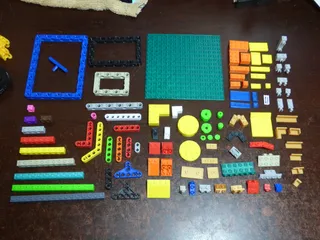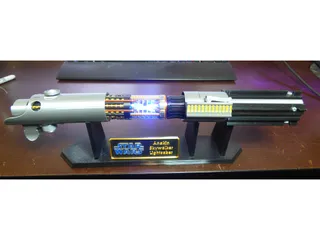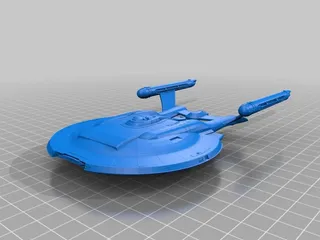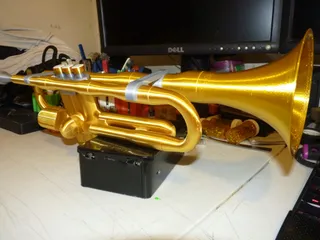Forge of Solus Prime
Description
PDFThis tool was featured in Transformers: Prime as one of Cybertron's ancient relics that were deposited on Earth sometime in the past by Alpha Trion, with the intent that it/they be later found and used by the Autobots to help in their war effort in the present day.
According to canon sources, the “real” Forge is nearly 4 meters long (from the top of the hub to the tip of the pommel), with a head about the size of a standard oil drum, while the big version of this project measures about 56 cm long, with a head about the size of a 3L soda bottle, making it ⅐ scale.
Its primary in-universe purpose is to build or repair things, but in a somewhat mystical/magical fashion. That is to say, when wielded by a Prime (or at least held in the hand of one), each strike of the Forge effects a functional or material change in the target object, transforming it into something else (and not merely bending/denting it).
Among other things, it was used to rebuild Optimus Prime's body, and to convert the Autobots' ground bridge into a full-range space bridge, allowing the team to travel back to Cybertron.
The Forge was later given to UItra Magnus after its power was depleted, to use as a blunt weapon, leading some to call it the “Magnus Hammer” (since he is usually depicted wielding some kind of ginormous hammer in other continuities).
It's the ultimate tool for “percussive maintenance”. 😉
I have tried to make this project screen-accurate, but the Forge is mostly only seen while some bot is swinging it around, and it's often surrounded by energon discharges, so it's hard to get a really good look at it on-screen. I consulted a number of images on the web, and I believe the image I used in the Blender project file for the size/scale guide is a screenshot from the TV series, but ultimately I had to take some minimal artistic license (such as guessing at the number of turbine blades and the shapes of the faces' edges).
Plus, most folks are gonna be using using plastic to make this, not metal (let alone Cybertonium or whatever the Forge supposed to be made of) so I had to make one or two minimal changes just to avoid parts being too weak (such as increasing the diameter of the handle).
As a bonus feature, the head's “turbine” assemblies can spin like in the TV series, thanks to a customized version of Emmett's famous planetary gear bearing. This project does not feature any lighting, nor are the turbines motorized, but it wouldn't be difficult to make that happen later.
While I tried to avoid super-tight tolerances so that just about any random printer could make this, there are a few places where I had no choice but to push my printer's limits, such as the “upper handle spike” pieces, and the “hanging lever mount” pieces. Thus, you'll need to make sure your machine and slicer are dialed-in well.
It's possible to scale this model up, if desired, but it's already pretty heavy as it is. Originally I was going for ¼ scale, but when I started throwing the models at Slic3r, I realized it would have ended up being ridiculously huge (to say nothing of the amount of filament it would have needed). Besides that, I wanted to make sure both of my printers could share the workload more or less evenly, so I dialed the size back a bit so that its largest parts could fit the smaller machine's 200x200 mm bed. I had actually intended this final model to be a nice, even ⅛ scale, but I got one of my measurements/estimates wrong, and that carried the rest of the model with it, bumping the final size up a tad. Oh well. 😉
You will need to use supports for a few parts, namely the turbine "hub end A" piece, the turbine “pall end B” piece, and the “hanging lever” piece. The hanging lever screw cap has its own support object built-in. Everything else should print fine without supports.
0.2 mm layers should be sufficient for the entire model, except maybe print the handle middle “ridges” pieces with 0.1 mm layers.
There are vertical holes in some pieces, which have a wider bottom opening than the top opening, e.g. screw holes that have an inset hole for the screw head, or parts with buried nut traps. On such parts, you'll need to use your slicer's hole-bridging feature (in Slic3r/SuperSlicer, go to Print Settings → Perimeters and Shell → No perimeters on bridge areas, and set that option to either “Remove perimeters” or “Fill voids with bridges”).
I strongly recommend using high-quality PETG for the handle, and PLA for the bearings would be a good idea.
While the “core bar” pieces should make the handle strong enough to safely wield your print with one hand in a controlled setting (provided you use high-quality filament), the head is pretty heavy, so if you plan to use this model in some sort of cosplay role or other uncontrolled environment where you'll be swinging it around a bit, I highly advise having someone mill the handle “core bar” pieces in metal of some kind, even just aluminum. It'll improve the prop's overall weight balance, in addition to the added strength.
DaKlush's “Magnus Hammer” model (https://www.thingiverse.com/thing:188456) is what inspired me to create this large-scale Forge.
Filaments used in my print:
- Atomic Metallic Silver PETG
- CC3D Silk Gold PLA
- Atomic translucent Aqua PETG
- Atomic Dark Blue Carbon Fibre PETG
- Atomic translucent Sapphire Blue PLA
- Atomic Bright White PLA
Assembly:
This is a complex model consisting of hundreds of individual parts, so take your time building it – don't rush.
The only vitamins you'll need are a handful of M3 and M4 screws, in assorted sizes ranging from 5 mm to 25-30 mm. Most of the M3 screws will need to be pan/button-head since those are low-profile. The four M4 screws that are visible on the completed model (in the handle top) should be cap-head, to better fit the style of the model.
Everything else is held together with snap-in clips, cleats, or press-fits. No glue needed.
Although I tried to make sure everything fits together well, even on a well-calibrated setup, you may still need to do a little sanding on the “handle core bar” parts (mostly just to take their edges off). Their tolerances are particularly tight compared to the rest of the model, since they're used for alignment in addition to strength (and they hold the handle pieces together from the ends).
This model is too complex to describe its assembly process here on the website, so I've prepared a detailed PDF, which can be found in the Files section, below the model files.
Toy-sized version:
All of the above refers to the big version, but this project also includes a “toy-size” version of the Forge, reduced to just 20% the size of the ⅐-scale model, making it 1/35 scale, the head of which is approximately the same size as DaKlush's model. It retains almost all of the detail of the big version, including turbines that can spin, but with some size/scale tweaks here and there to make sure the parts won't be too weak.
To make this version, you'll need two M3 x 35 mm pan- or button-head screws, nuts, four 623ZZ bearings, some 1.75 mm filament that hasn't been run through an extruder (we don't want the distortions that come with that), and superglue.
Assembly of this version is pretty straightforward.
First press a nut into each hub half, then use super glue, bits of filament, and a clamp to fix the two hub halves together. Then, each turbine and pall can simply attach to the hub with a screw.
Once the head is assembled and the screws are torqued-down, make sure the palls are properly oriented, then put a drop of super glue or some kind of hard threadlock on the head of each screw to lock it to the pall.
What isn't evident from the photo is that inside each “turbine” section is a sleeve that rides on the screw (and which is isolated from the inside of the turbine). This sleeve serves to hold the turbine's bearings apart via their centers. Those bearings and the sleeve are compressed between the hub and pall when the screw is tightened, leaving the turbine free to turn. Since there's no significant force being exerted on the bearings' outer sections, you can apply a LOT of force on the screws without compromising anything (well, up to the limit of the plastic, anyway).
Also, if you glue bits of filament into the four holes in each of the head's faces and let the glue cure, you can then simply press the filament bits into their respective holes in each pall, and friction will keep the faces in place. This allows you to easily take a face off to get to the screw it hides, if needed.
The handle prints in four parts, all of which simply slide onto a long piece of filament.
You will need to use 0.1 mm layers on most of this version, and you'll need some exceptionally-good part cooling. You'll have to forgive my slightly rough-looking print of this size… part cooling on my printer is just kinda middle-of-the-road, and the toy size model has LOTS of thin overhanging bits, which has always been the bane of my existence. 😛 FDM is fine and all, but for something this small with this much detail, it would be better to use an SLA/resin printer, or a powder-based SLS machine if you have access to one.
The holes for the bits of filament are 2.0 mm in diameter in the model, but in a real print, they'll be just barely the right size to hold 1.75 mm filament. In fact, you'll almost certainly have to ream some of the holes with a 1.75-1.8 mm drill bit or a needle file.
It isn't feasible to print this one-color-one-part at a time like with the big version, so if you want all features in this size to be properly-colored, you'll have to either use a printer with color-switching capability, or you'll need to paint it. I took a middle ground, printing in gold for the hub, palls, and pommel, and silver for everything else, then a few strokes with a light blue sharpie to add “energon” coloring here and there.
Changelog:
2022-06-06: added a “toy-size" version.
2022-05-22: added brackets to mount/hang the Forge on a wall.
Copyright notice:
Although it is obviously based on a commercial property, this project is entirely my own work, with the exception of a modified version of Emmett's well-known planetary gear bearing.
Since I designed and drew all other parts of this model entirely from scratch, using images found via Google Image Search purely as reference material, this project is clearly a transformative work.
As such, I claim full copyright on this model and all parts and files thereof, except for the bearing, at least to the extent that such claim is permitted by the public CC-By-SA-NC license this model is published under.
SMALL PARTS
This model contains many small parts which could be dislodged and which may present a choking hazard to small children.
Model origin
The author marked this model as their own original creation.




